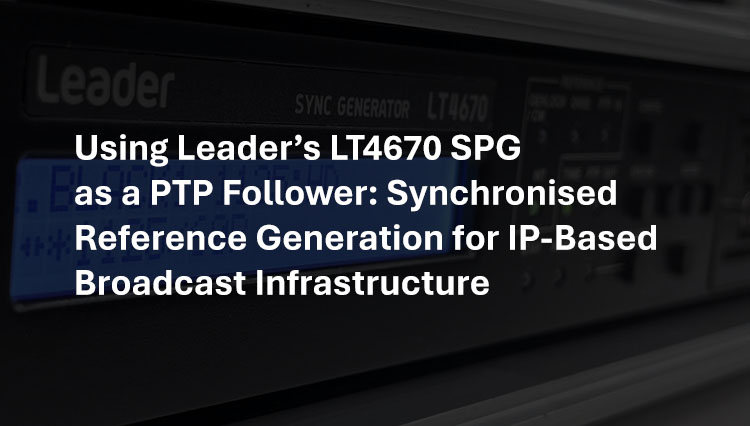As the broadcast and production industries continue their migration to IP-based infrastructures, maintaining tight and accurate synchronization across all equipment becomes more complex and more critical. Traditional reference signals like Black Burst (BB) and Tri-Level Sync (TLS) still serve essential roles, even in increasingly IP-centric workflows.
To bridge this gap, Leader’s LT4670 Sync Pulse Generator (SPG) offers a powerful solution. With support for PTP (Precision Time Protocol) as a follower, the LT4670 ensures your legacy and digital systems stay perfectly aligned with the PTP Grandmaster used across your facility’s IT backbone.
Why Synchronization Matters in a Hybrid IP/SDI Broadcast Environment
Precise synchronization is critical in broadcast engineering. A single frame offset between video and audio or between multiple camera feeds can lead to costly errors and post-production rework.
PTP (IEEE 1588-2008) has emerged as the new standard for time synchronization in professional media networks. It’s central to SMPTE ST 2059, which defines how PTP is used in the context of ST 2110 IP production workflows. However, not all equipment is ready to natively support PTP.
That’s where the LT4670 SPG excels, as well as serving as a Grandmaster, it can also serve as a PTP follower that locks to the master clock on your IP network and then outputs traditional reference signals for SDI and AES3 equipment, allowing for seamless hybrid operation.
LT4670 as a PTP Follower
The LT4670 can also act as a PTP follower device, meaning it receives and synchronizes to a PTP Grandmaster over Ethernet. Once locked, the LT4670 uses that timing to drive all of its output references.
Key Capabilities:
· SMPTE ST 2059-2 compliance for professional media environments
· Redundant Ethernet ports for high-reliability PTP reception
· Low-jitter PLL-based generation of reference signals phase-aligned to PTP time
· Stable holdover with a high-quality internal oscillator to maintain sync if the PTP source is lost
Reference Outputs Provided by the LT4670
When locked to a Grandmaster via PTP, the LT4670 provides a wide range of reference signals for SDI and AES3-based systems. All outputs are precisely aligned to the PTP domain, ensuring consistent sync across your infrastructure.
1. Black Burst (BB)
· Standard analog reference used in SD/SDI workflows
· Phase-aligned to PTP time, ensuring frame-accurate video sync
2. Tri-Level Sync (TLS)
· Used in HD and UHD systems (1080i/p, 4K)
· Provides greater timing precision than BB, with less interference on HD signals
3. AES3 Digital Audio Reference (DARS)
· AES-compliant digital audio reference signal
· Ensures audio gear (e.g., digital consoles, embedders) stay locked to a common timing source
· Perfect for lip-sync maintenance and multichannel audio workflows
These outputs maintain phase continuity with the PTP Grandmaster, creating a unified timing foundation whether your devices are IP-native or legacy.
Integration Example: LT4670 + Meinberg Grandmaster
Here’s a typical hybrid workflow deployment:
1. A Meinberg LANTIME PTP Grandmaster provides highly accurate PTP timing over a dedicated broadcast VLAN.
2. The LT4670 connects to this VLAN over one or both of its Ethernet interfaces and acts as a PTP follower.
3. Once synchronized, the LT4670 distributes:
· BB to switchers, VTRs, and SD monitoring systems.
· TLS to HD/4K routers, cameras, and servers.
· AES3 to digital audio consoles, embedders, and routers.
4. As Meinberg do not provide an Emergency Changeover Unit, the Leader LT4670 seamlessly integrates with the Leader LT4448 Emergency Changeover Unit and allows facilities to have robust and reliable reference sources, that are locked to the broadcast facilities IP references.
This setup allows a facility to maintain strict timing across both modern and legacy systems, streamlining operations and preventing drift-related issues.
Supported Clock Sources on the LT4670
In addition to PTP, the LT4670 supports a versatile range of reference clock sources, allowing for flexible integration into existing and transitioning facilities:
Clock Source Options:
PTPv2 (IEEE 1588-2008):
· Used when operating as a PTP follower/slave.
· Synchronizes to Grandmasters.
Analog Video Reference Input:
· Supports BB or TLS input for traditional analog sync fallback.
· Ideal in SDI-only or fallback environments.
10 MHz Reference Input:
· Common reference format from GPS-locked sources or master oscillators.
· Used in larger timing ecosystems or for GPS-disciplined accuracy.
Internal OCXO Oscillator:
· Provides high-stability clock generation when external sources are unavailable.
· Supports stable holdover performance during PTP source outages.
This flexibility allows engineers to deploy the LT4670 in a wide range of broadcast and live production contexts, whether as the primary generator or as a backup sync solution.
Conclusion
The LT4670 SPG is not just a traditional sync generator, it’s a powerful tool for synchronizing hybrid production infrastructures. By acting as a PTP follower, it seamlessly aligns legacy analog and digital reference signals with the precision of modern IP-based timing systems.
With support for multiple reference clock sources, including PTP, 10 MHz, analog video sync, and internal oscillator, the LT4670 offers unmatched deployment flexibility. Whether you’re building a new IP facility or upgrading an existing SDI plant, the LT4670 ensures your entire ecosystem – video, audio, and control runs on a single, stable timeline.

